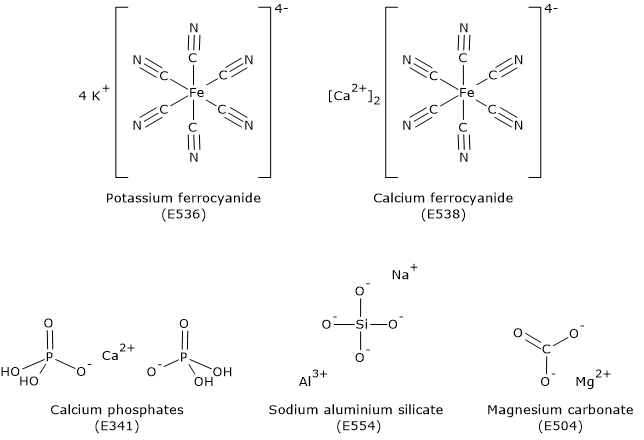Anti-caking agents are additives used in the production of powdered or dried foods to prevent aggregation and, consequently, the formation of lumps.[1][2]
Lump formation can be caused by the presence of hygroscopic compounds in food, which tend to absorb water vapor from the atmosphere, and/or by lipids that may bind together.[3]
The most common anti-caking agents include inorganic salts such as carbonates, phosphates, and silicates.[4]
Anti-caking agents have three distinct modes of action.
- They absorb excess moisture by selectively binding water molecules, thereby preventing interaction with hygroscopic substances that may be present.
- They render the surfaces of fatty substances water-repellent by forming a protective hydrophobic film.
- They inhibit the aggregation of lipids.[5][6]
Anti-caking agents therefore help to maintain the solubility and quality of food without compromising its appearance.[1][7]
Their use is also essential in the processing of foods made from powdered materials. Without them, lumps could form in the conduits of machines such as dough mixers.[2] This problem may also occur in vending machines that dispense milk-based drinks, coffee, sugar, or cocoa.[5][8]
Contents
Foods they are added to
They are added to foods such as cocoa, powdered milk, icing sugar, table salt, flavorings like onion or garlic powder mixed with salt, grated cheese, cake mixes, baking powder, powdered eggs, instant coffee, powdered supplements, and tablets.[7]
 Like other food additives, anti-caking agents are identified not only by their name but also by their E-numbers, where “E” stands for Europe.[9] Since a wide variety of processed foods can form lumps, one or more specific anti-caking agents are used for each type of food.
Like other food additives, anti-caking agents are identified not only by their name but also by their E-numbers, where “E” stands for Europe.[9] Since a wide variety of processed foods can form lumps, one or more specific anti-caking agents are used for each type of food.
Examples of anti-caking agents
Below is a brief overview of some anti-caking agents included in the list of food additives authorized for use in the European Union, according to Regulation (EU) No. 1129/2011 of the European Commission, published on 11 November 2011. This list amended Annex II of Regulation (EC) No. 1333/2008 of the European Parliament and was itself amended again in 2013.[10]
| E-number | Additive |
|---|---|
| E170 | Calcium carbonate |
| E341 | Calcium phosphates |
| E460 | Cellulose |
| E504 | Magnesium carbonate |
| E535 | Sodium ferrocyanide |
| E536 | Potassium ferrocyanide |
| E538 | Calcium ferrocyanide |
| E551 | Silicon dioxide |
| E552 | Calcium silicate |
| E553a | Magnesium silicate |
| E553b | Talc |
| E554 | Sodium aluminium silicate |
| E555 | Potassium aluminium silicate |
| E556 | Calcium aluminium silicate |
Health effects
The safety of foods containing anti-caking agents is evaluated, as with all other food additives, by the competent authorities, whose decisions are based on the scientific literature available at the time of the assessment. Based on current evidence, anti-caking agents, when used in accordance with specific guidelines, are considered safe for human health.[11][12]
References
- ^ a b Belitz H.-D., Grosch W., Schieberle P. Food Chemistry. 4th Edition. Springer, 2009.
- ^ Fu Y., Luo F., Ma L., Dai H., Wang H., Chen H., Zhu H., Yu Y., Hou Y., Zhang Y. The moisture adsorption, caking, and flowability of silkworm pupae peptide powders: the impacts of anticaking agents. Food Chem 2023;419:135989. doi:10.1016/j.foodchem.2023.135989
- ^ Chen M., Wu S., Xu S., Yu B., Shilbayeh M., Liu Y., Zhu X., Wang J., Gong J. Caking of crystals: characterization, mechanisms and prevention. Powder Technol 2018:337;51-67. doi:10.1016/j.powtec.2016.12.015
- ^ Bender D.A. Benders’ Dictionary of Nutrition and Food Technology. 8th Edition. Woodhead Publishing. Oxford, 2006.
- ^ a b Fattinonfake.federchimica.it. Niente grumi… grazie agli antiagglomeranti. 7 ottobre 2021.
- ^ Pui L.P., Saleena L.A.K., Ghazali H.M. Storage stability and anti-caking agents in spray-dried fruit powders: a review. Food Mater Res 2024;12(2):229-239. doi:10.21603/2308-4057-2024-2-603
- ^ a b Damodaran S., Parkin K. Fennema’s Food Chemistry. 5th Edition. CRC Press, 2017.doi:10.1201/9781315372914
- ^ Ueda J.M., Morales P., Fernández-Ruiz V., Ferreira A., Barros L., Carocho M., Heleno S.A. Powdered foods: structure, processing, and challenges: a review. Appl Sci 2023;13(22):12496. doi:10.3390/app132212496
- ^ Food Standards Agency. Approved additives and E Numbers. Last updated: 16 July, 2025.
- ^ Commission Regulation (EU) No 1129/2011 of 11 November 2011 amending Annex II to Regulation (EC) No 1333/2008 of the European Parliament and of the Council by establishing a Union list of food additives. https://eur-lex.europa.eu/eli/reg/2011/1129/2013-11-21
- ^ EFSA FAF Panel (EFSA Panel on Food Additives and Flavourings), Younes M., Aquilina G., Castle L., et al. Re-evaluation of silicon dioxide (E 551) as a food additive in foods for infants below 16 weeks of age and follow-up of its re-evaluation as a food additive for uses in foods for all population groups. EFSA Journal 2024;22(10):e8880. doi:10.2903/j.efsa.2024.8880
- ^ EFSA Food additives. Last reviewed date: 18 July 2025.